
Vineyards in Slovenia
Croatia
Like the rest of Central Europe, Croatia has a long tradition of grape cultivation and winemaking that started well before the Romans. The country has two major wine growing areas: the Continental region and the Coastal region. The Continental region has a continental climate and produces mostly white wines. Grasevina, also known as Welschriesling in Austria, is the most widely planted variety in the area. The Coastal region runs along the Adriatic coast and enjoys a temperate Mediterranean climate. The region produces both white and red wines from many indigenous varieties as well as imported Bordeaux varieties.
The wines we tasted:
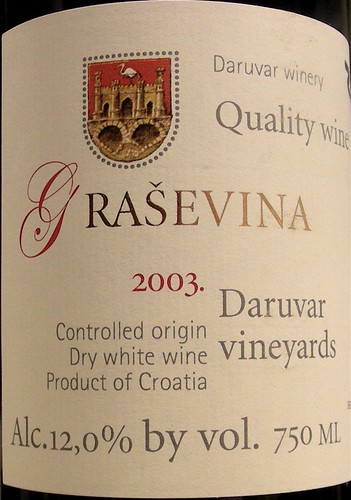 • 2003 Daruvar Grasevina: The Daruvar Winery is one of the most modern wineries in Croatia. It has its own vineyards and a modern wine cellar and bottling plant. The wine comes from a traditional wine growing district in Croatia's continental region. It is made of Grasevina, the most planted white grape variety in Croatia. Grasevina is also called Welschriesling in Austria and Germany, Riesling Italico in Italy, Olasz rizling in Hungary, Laski rizling in Slovenia, and Vlassky rizling in Czech republic. When yields are moderate, it produces a style of wine that is floral and zesty with a pleasant bitter aftertaste. My notes: straw color, nose of cherry stone, nutty and citrusy on the palate with a tangy acidity. Tastes better than it smells.
• 2003 Daruvar Grasevina: The Daruvar Winery is one of the most modern wineries in Croatia. It has its own vineyards and a modern wine cellar and bottling plant. The wine comes from a traditional wine growing district in Croatia's continental region. It is made of Grasevina, the most planted white grape variety in Croatia. Grasevina is also called Welschriesling in Austria and Germany, Riesling Italico in Italy, Olasz rizling in Hungary, Laski rizling in Slovenia, and Vlassky rizling in Czech republic. When yields are moderate, it produces a style of wine that is floral and zesty with a pleasant bitter aftertaste. My notes: straw color, nose of cherry stone, nutty and citrusy on the palate with a tangy acidity. Tastes better than it smells. • 2005 Kozlovic Malvazija Istria: The Kozlovic family founded the Kozlovic Estate four generations ago. The winery is located in the Istria peninsula, the largest peninsula in the Adriatic Sea. Sometimes described as the New Tuscany, Istria's wine country is made of lush valleys surrounded by olive groves and steep hillsides terraced for vineyards. On the coast, picturesque seaside towns have preserved their Venetian colonial character. Malvazija or Malvasia Istriana, a white grape clone from the Malvasia family, is the most widely planted white grape in Istria. My notes: fragrant and floral nose, nice acidity on the palate with dried herbs and spicy flavors. Quite a distinctive wine.
• 2005 Kozlovic Malvazija Istria: The Kozlovic family founded the Kozlovic Estate four generations ago. The winery is located in the Istria peninsula, the largest peninsula in the Adriatic Sea. Sometimes described as the New Tuscany, Istria's wine country is made of lush valleys surrounded by olive groves and steep hillsides terraced for vineyards. On the coast, picturesque seaside towns have preserved their Venetian colonial character. Malvazija or Malvasia Istriana, a white grape clone from the Malvasia family, is the most widely planted white grape in Istria. My notes: fragrant and floral nose, nice acidity on the palate with dried herbs and spicy flavors. Quite a distinctive wine.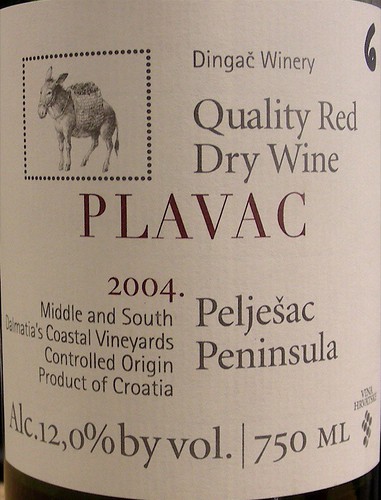 • 2004 Dingac Plavac Peljesac Peninsula: wines made in the Dingac area of the Peljesac Peninsula on the Dalmatian Coast are well renowned in Croatia. The grape is Plavac Mali, an indigenous variety that has strong morphologic similarities with Zinfandel. Plavac Mali was first thought to be Zinfandel's ancestor but DNA results showed that a native grape called Crljenak Kastelanski, — actually a parent of Plavac Mali — was the true Croatian counter part of Zinfandel. My notes: this wine comes from the Dingac farming cooperative and winery. Dark brick color, medicinal nose, aromas of wet mushroom. On the palate, dried tannins, rather short finish.
• 2004 Dingac Plavac Peljesac Peninsula: wines made in the Dingac area of the Peljesac Peninsula on the Dalmatian Coast are well renowned in Croatia. The grape is Plavac Mali, an indigenous variety that has strong morphologic similarities with Zinfandel. Plavac Mali was first thought to be Zinfandel's ancestor but DNA results showed that a native grape called Crljenak Kastelanski, — actually a parent of Plavac Mali — was the true Croatian counter part of Zinfandel. My notes: this wine comes from the Dingac farming cooperative and winery. Dark brick color, medicinal nose, aromas of wet mushroom. On the palate, dried tannins, rather short finish.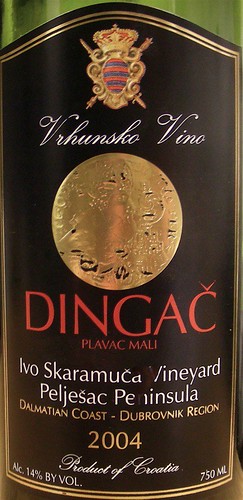 • 2004 Ivo Skaramuca Dingac Plavac Mali Peljesac Peninsula: this is another Plavac Mali wine from the Dingac district. It is produced by the Ivo Skaramuca Estate, named after the owner and winemaker Ivo Skaramuca. My notes: dark red color, sweet fruit and burnt sugar aromas. On the palate, nicely balanced acidity and tannins, ripe banana flavor on the finish. For me, this was a much better wine than the previous Dingac.
• 2004 Ivo Skaramuca Dingac Plavac Mali Peljesac Peninsula: this is another Plavac Mali wine from the Dingac district. It is produced by the Ivo Skaramuca Estate, named after the owner and winemaker Ivo Skaramuca. My notes: dark red color, sweet fruit and burnt sugar aromas. On the palate, nicely balanced acidity and tannins, ripe banana flavor on the finish. For me, this was a much better wine than the previous Dingac.Slovenia
According to archaeological findings, winemaking began in Slovenia some 2400 years ago. We suspect that Celtic tribes that lived in northeastern Slovenia knew how to make wine long before the Romans. They also knew how to make barrels from the local oaks. Located between the southern slopes of the Alps and the Mediterranean sea, Slovenia produces a wide range of wine styles, from aromatic German or Italian-inspired whites to full-bodied Bordeaux-style reds.
The wines we tasted:
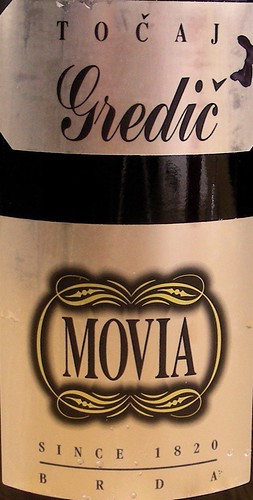 • 2004 Movia Tocaj Gredic Goriska Brda:
• 2004 Movia Tocaj Gredic Goriska Brda:The wine comes from the Goriska Brda region, along the Italian-Slovenian border. In Slovene, brda means hills and the region corresponds to the Italian appellation Collio in southeastern Friuli. In Brda, the Movia estate has been producing wine for more than three centuries. The current owner is the charismatic Ales Kristancic, who believes in a completely natural approach to grape-growing and winemaking and uses biodynamic principles to farm his vineyard. My notes: bright color, nose of pear and honey, crisp on the palate with caramelized apple flavors, refreshing finish. Very nice!
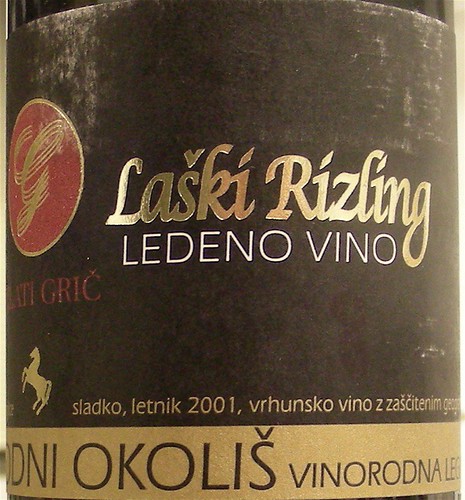 • 2001 Zlati Gric Laski Rizling Ledeno Vino: produced by the Zlati Gric Winery (means golden hill in Slovene), this is a Welschriesling (Laski Rizling) ice wine (Ledeno Vino) from the Maribor area, a region with a strong German influence and with the best white wines similar to those grown in the Rhine and Mosel valleys. For this wine, the grapes were harvested in November at -10ºC then pressed at the same temperature in order to keep the ice crystals formed inside the grape berries and only extract the sweet, concentrated juice. My notes: greenish color, smoky nose, sweet and meaty on the palate, slightly soapy finish. On its website, the winery recommends pancakes with chocolate stuffing, nut roll, or dried fruit with the wine.
• 2001 Zlati Gric Laski Rizling Ledeno Vino: produced by the Zlati Gric Winery (means golden hill in Slovene), this is a Welschriesling (Laski Rizling) ice wine (Ledeno Vino) from the Maribor area, a region with a strong German influence and with the best white wines similar to those grown in the Rhine and Mosel valleys. For this wine, the grapes were harvested in November at -10ºC then pressed at the same temperature in order to keep the ice crystals formed inside the grape berries and only extract the sweet, concentrated juice. My notes: greenish color, smoky nose, sweet and meaty on the palate, slightly soapy finish. On its website, the winery recommends pancakes with chocolate stuffing, nut roll, or dried fruit with the wine.Romania
Romania ranks tenth among the world's top wine producers by volume. Thanks to the country's mild Mediterranean climate and fertile Danube Delta, Romania produces many different types of wines, from dry, sparkling whites to full-bodied reds. After the phylloxera epidemic, many indigenous vines were replaced by varietals imported from Europe, such as Cabernet Sauvignon, Merlot, Chardonnay, and Pinot Noir.
The wines we tasted:
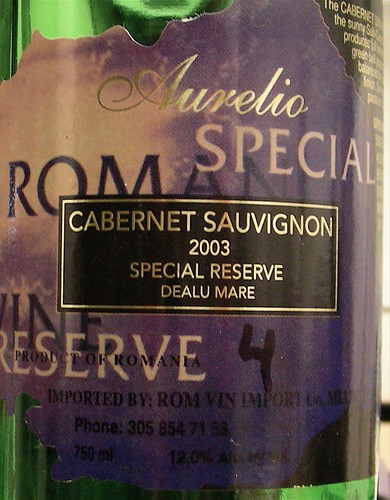 • 2003 Aurelio Cabernet Sauvignon Special Reserve Dealu Mare: the wine is produced by the Rovit Valea Calugareasca winery in the Dealu Mare appellation. Dealu Mare, which means big hill in Romanian, produces mostly red wines from Cabernet Sauvignon, Merlot, and Pinot Noir, as well as the indigenous Black Feteasca. My notes: brick color, smoky nose of sweet caramel, green and tannic palate, seems oxidized.
• 2003 Aurelio Cabernet Sauvignon Special Reserve Dealu Mare: the wine is produced by the Rovit Valea Calugareasca winery in the Dealu Mare appellation. Dealu Mare, which means big hill in Romanian, produces mostly red wines from Cabernet Sauvignon, Merlot, and Pinot Noir, as well as the indigenous Black Feteasca. My notes: brick color, smoky nose of sweet caramel, green and tannic palate, seems oxidized.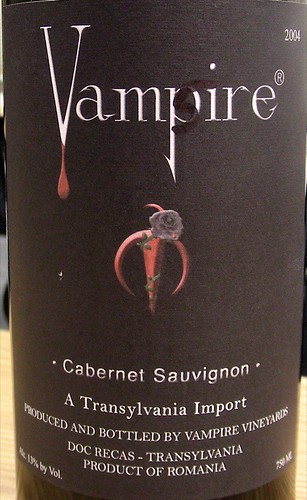 • 2004 Vampire Cabernet Sauvignon Recas: the wine is produced by Vampire Wines, a winery that successfully exports its wines to the United States, Canada, and Europe. Not surprisingly, its best selling month is in October, just before Halloween! My notes: dark red color, nose of black fruit, spices and tar, balanced acidity and tannins on the palate, some greeness on the finish but overall, rather pleasant.
• 2004 Vampire Cabernet Sauvignon Recas: the wine is produced by Vampire Wines, a winery that successfully exports its wines to the United States, Canada, and Europe. Not surprisingly, its best selling month is in October, just before Halloween! My notes: dark red color, nose of black fruit, spices and tar, balanced acidity and tannins on the palate, some greeness on the finish but overall, rather pleasant.I really enjoyed taking this class. The company was great. Derrick was very knowledgeable and such a big fan of German Riesling! The wines were often delicious, sometimes surprising, always interesting. Highly recommended class for the curious minded who likes to experience uncommon flavors and wine styles.
Related stories:
• Wines of Germany and Eastern Europe class: Rheingau, Mosel-Saar-Ruwer, and Mittelrhein
• Wines of Germany and Eastern Europe class: Nahe, Rheinhessen, and Pfalz
• Wines of Germany and Eastern Europe class: Kremstal, Kamptal, and Wachau (Austria)
• Wines of Germany and Eastern Europe class: Hungary
Technorati tags: wine food & drink
12 comments:
Hi! We Slovenians truly have a long winegrowing tradition. As I could read you have tried two brands, but still there are many very famous wines you should definetly taste. The best way is to come to visit Slovenia and take a tour on Slovenian wine tracks...tehre are many of them:)
I would love to visit the country! And I hope that we'll find eventually more Slovenian wines in this country.
Same here and same here. Literally.
I'm posting about Movia to my blog -- the only Slovenian wine I've tasted (and it's the Tocai varietal too). A hobby like wine often leads you to realize how big the world is.
Thanks for the nice post!
thanks ur information
Post a Comment